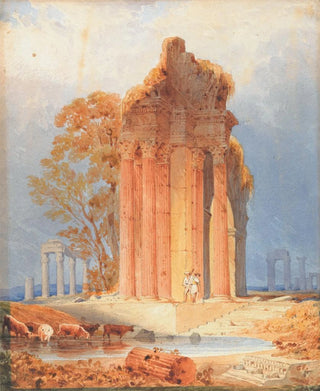Art print | Abreuvement du bétail par des colonnes corinthiennes - Copley Fielding


View from behind

Frame (optional)
In a world where harmony between nature and architecture reveals itself in all its splendor, the art print "Abreuvement du bétail par des colonnes corinthiennes" by Copley Fielding emerges as a celebration of bucolic beauty and classical grandeur. This canvas, imbued with serenity, transports us to the heart of a pastoral scene where livestock, a symbol of rural life, drinks peacefully under the protective shade of Corinthian columns. The artist, through his skill in capturing light and textures, invites us to contemplate a moment frozen in time, where nature and architecture meet with infinite grace.
Style and uniqueness of the work
Fielding's art print stands out for its romantic style, characterized by a palette of soft colors and a diffuse light that envelops the scene in a calming atmosphere. The majestic and elegant Corinthian columns rise in the background, adding an architectural dimension to this pastoral depiction. The artist excels in the art of perspective, creating a depth that immerses us in the heart of this landscape. The meticulous details of the animals and natural elements testify to attentive observation, while the play of light accentuates shapes and volumes. Thus, the art print reveals itself as a dialogue between man, nature, and art, where each element finds its place in a harmonious balance.
The artist and his influence
Copley Fielding, an emblematic figure of 19th-century English landscape painting, knew how to mark his era with his unique vision of nature. Influenced by the Romantic movement, he expressed a deep sensitivity towards British landscapes through his works. Fielding was also inspired by the old masters, integrating classical elements into his compositions. His innovative approach paved the way for a new appreciation of the landscape, where nature is not only a subject but also an active participant. His legacy endures, influencing many contemporary artists who seek to capture the beauty of the natural world with similar sensitivity.

Matte finish

View from behind

Frame (optional)
In a world where harmony between nature and architecture reveals itself in all its splendor, the art print "Abreuvement du bétail par des colonnes corinthiennes" by Copley Fielding emerges as a celebration of bucolic beauty and classical grandeur. This canvas, imbued with serenity, transports us to the heart of a pastoral scene where livestock, a symbol of rural life, drinks peacefully under the protective shade of Corinthian columns. The artist, through his skill in capturing light and textures, invites us to contemplate a moment frozen in time, where nature and architecture meet with infinite grace.
Style and uniqueness of the work
Fielding's art print stands out for its romantic style, characterized by a palette of soft colors and a diffuse light that envelops the scene in a calming atmosphere. The majestic and elegant Corinthian columns rise in the background, adding an architectural dimension to this pastoral depiction. The artist excels in the art of perspective, creating a depth that immerses us in the heart of this landscape. The meticulous details of the animals and natural elements testify to attentive observation, while the play of light accentuates shapes and volumes. Thus, the art print reveals itself as a dialogue between man, nature, and art, where each element finds its place in a harmonious balance.
The artist and his influence
Copley Fielding, an emblematic figure of 19th-century English landscape painting, knew how to mark his era with his unique vision of nature. Influenced by the Romantic movement, he expressed a deep sensitivity towards British landscapes through his works. Fielding was also inspired by the old masters, integrating classical elements into his compositions. His innovative approach paved the way for a new appreciation of the landscape, where nature is not only a subject but also an active participant. His legacy endures, influencing many contemporary artists who seek to capture the beauty of the natural world with similar sensitivity.






